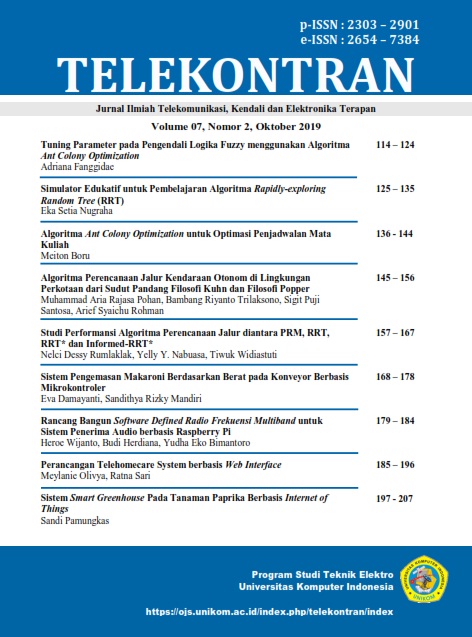Educational Simulator for Teaching of Rapidly-exploring Random Tree (RRT) Algorithms
Main Article Content
Abstract
Abstract - This paper presents the design and use of educational simulators to assist in teaching motion planning material using the Rapidly-exploring Random Tree (RRT) algorithm. This simulator is made using Laboratory Virtual Instrumentation Engineering Workbench (LabVIEW). In this educational simulator also made several variations of the RRC, namely RRT*, bi-RRT and RRT biased. The advantage of this simulator is that each subprocess of the RRT algorithm can be visualized so that it will help improve understanding in learning this algorithm. The parameters of the RRT algorithm can also be easily modified so that they can be observed for the output performance of the RRT. Simulator performance testing is done by comparing its implementation in several existing benchmark cases. Because one of the important things in the path planning algorithm is about computational time, making this simulator software has been streamlined in order to obtain minimal system computing time. Using one of the benchmark cases in path planning, the RRT algorithm is designed to be able to arrange a path in 185 milliseconds, whereas if using the RRT* algorithm, the path planning can be completed in 1273 milliseconds. One of the ways to minimize this computation time is by minimizing overhead on subVI programs. Subhead overheads are minimized by making them subroutines. Therefore, the design of this simulator also avoids the use of functions in LabVIEW which cannot be used as subroutines. Using this simulator is expected to help students to get a better understanding of the motion planning algorithm using RRT.
Keywords Â: Motion planning, Rapidly-exploring Random Tree, simulators, RRT variations, process visualization
Downloads
Article Details
Section

This work is licensed under a Creative Commons Attribution-ShareAlike 4.0 International license.
